IN-DEPTH / IN-DEPTH
Tibetan villager resettlement program leads to improved ecology in Qinghai
○ From 2005, more than 50,000 Tibetan herdsmen have abandoned the nomadic life in order to preserve the fragile ecology in Northwest China's Qinghai Province
○ The herdsmen were resettled in villages with better environments and living conditions
○ Now after 15 years, they are living better lives and seeking to keep their traditional culture
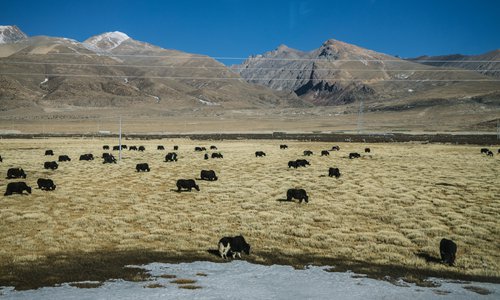
Aqie Jamo, 29, still gets frightened when she looks back on her childhood experience of herding sheep alone in the mountains.
Once, when she was 7, she and her flock got caught in a storm, and all she could do was find a hole in the ground and hide inside it.
Aqie Jamo is the daughter of a Tibetan herdsman. At that time, her whole family lived a nomadic life in the Tuotuo River area in the Tanggula Mountains, in Northwest China's Qinghai Province. Their hometown of Tanggula is 4,700 meters above sea level.
Like many other children from herding families, Aqie Jamo had to live at school, as it could take up to six hours to get there by yak. She had to tend to the sheep for the family during holidays.
Tuotuo River is the origin of the Yangtze, China's longest river, which passes through 11 provincial regions.
Tuotuo River is in Sanjiangyuan, which means "source of three rivers," referring to the Yangtze, Yellow and Lancang (Mekong) rivers.
The Sanjiangyuan is also home to 270 species of wild land vertebrates, 69 of which are under State protection.
However, over the past decades, "as a result of climate change and some unreasonable human activities, large areas of grassland have become degraded and rendered arid," according to Ecological Resettlement in Sanjiangyuan of Qinghai by Du Fachun, a professor at Yunnan Agricultural University who studies the resettlement.
In 2000, the Sanjiangyuan Nature Reserve was established in Qinghai. In 2004, the State Council approved a project to protect Sanjiangyuan. Since 2005, China has invested 18 billion yuan ($2.68 billion) in protecting the area, the Xinhua News Agency reported Monday.
Resettlement was an important part of the project. Over 55,000 herdsmen from 10,140 households abandoned the nomadic life and settled down in brick houses on the Qinghai-Tibet Plateau, according to the Xinhua.
Aqie Jamo was one of them. She was resettled in Changjiangyuan village, 10 minutes by car from Golmud, the second largest city in Northwest China's Qinghai Province. Golmud is around 2,800 meters above sea level.
Her family now live in a house with four rooms and a large yard. The living room is decorated with beautifully carved furniture made in Lhasa, Southwest China's Tibet Autonomous Region, 1,200 kilometers away.
Aqie Jamo now works in the local town government. Her husband is a police officer. Every month, he spends 15 days in the Tuotuo River area in Tanggula, where Aqie's family used to live.
Aqie Jamo's two children, who are 6 and 1, do not have to experience the harsh childhood their mother did. Every morning, Aqie Jamo drives her older child to school in Golmud city.
"There are more social resources here, which make our lives easier," Aqie Jamo said. "Also, there is more oxygen."
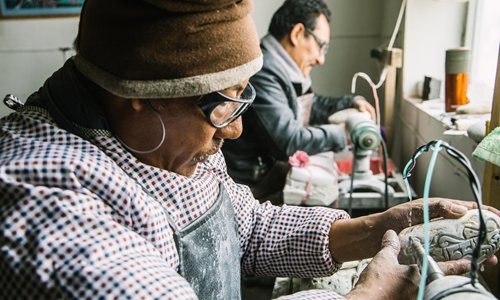
Hard decision
"Before relocation, the grassland had been degrading. It was quite windy, with a lot of sand and dust. The ecology was fragile," Xin Xiangdong, a Tibetan and then mayor of Tanggula town, explained, giving a brief history of Changjiangyuan village.
Xin is now the deputy chief of the standing committee of the people's congress of Golmud.
"In May or June 2004, the province launched the ecological resettlement project. We had a meeting in our town, and decided we would join the project," he told the Global Times in Changjiangyuan village in late March.
Xin and his colleagues then spent two months going from one tent to the next in an attempt to persuade villagers.
"It was very difficult to change their thinking," Xin said.
Compounding the problem, policies on subsides were very unclear at the time, which meant that each household could only receive around 5,500 yuan a year for giving up herding.
Finally, 407 residents from 128 households agreed to move. "They did it for their children's future," Xin said.
In September, construction at Changjiangyuan village began. By November, it was completed.
Soon, the Tibetan herdsmen sold their yaks and sheep and moved to their new home - Changjiangyuan village in the suburbs of Golmud city, 500 kilometers from their hometown.
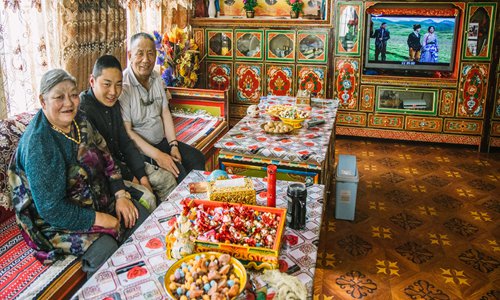
Better life
After 15 years, the lives of the Changjiangyuan villagers have changed greatly. With the help of the local government, they have adapted to urban life while striving to maintain their traditional culture.
Of the 600 villagers, more than 100 work as rangers in the wetlands, and each household has one ranger who works on the grasslands at the Sanjiangyuan Nature Reserve.
Some villagers find seasonal jobs, such as digging for caterpillar fungus or herding in the grasslands from April to October each year. "The Tibetan herdsmen are very adaptable. They live an 'amphibious' life," Du told the Global Times in an interview in Beijing.
Some villagers have opened Tibetan restaurants in logistics centers in Golmud, which is a major supply point for the Qinghai-Tibet highway, Du said.
Since 2011, under the support of the central government, Qinghai has begun applying subsidy and reward policies for grassland ecology protection. Since then, the villagers have been able to receive subsidies worth tens of thousands of yuan a year.
The average income of each villager has soared from 2,000 yuan in 2004 to around 20,000 yuan every year now, Xin said.
The children can attend a bilingual school in the village. The primary school has more than 50 teachers and 600 students, including those from neighboring villages.
A change of lifestyle has also meant a change of eating habits for the former herdsmen. As they no longer need to work in high altitudes or cold mountains, they are now able to get a more balanced diet, eating more vegetables.
The village has a library with books in Tibetan, and villagers can use the Tibetan monastery in Golmud city.
Moreover, the village has 59 surveillance cameras, and there have been no reports of crimes taking place there.
Tourism featuring Tibetan culture is also being promoted under the plan.
"This year and next year, we will put 2 billion yuan into renovating the houses in the village, making it more Tibetan-looking," said Xin.
In August 2016, Chinese President Xi Jinping visited the village and received a warm welcome. A photo of Xi, Sanjiangyuan villagers and Xin, who served as the interpreter, hangs in the village committee building.
The 11th Panchen Lama Bainqen Erdini Qoigyijabu visited the village in 2018.
Now, the village has more than 100 Communist Party of China members, and more herdsmen are expressing a wish to move to the village.
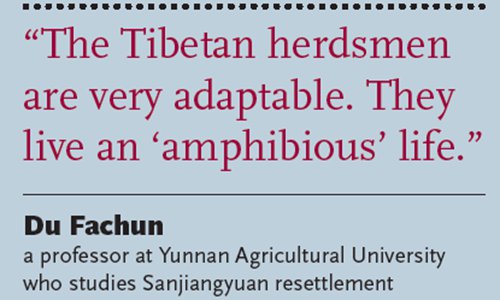
Woman power
Everybody in Changjiangyuan village knows Sanmuji, a local woman entrepreneur.
At the Gampapo handicraft cooperative in the village, 33-year-old Sanmuji introduced the organization's products, which include carved praying stones, Tibetan carpets and paintings.
"The handmade smart phone cases are unique. They cost 280 yuan each," she said. "The Marnyi stones are the most popular products."
Three years ago, as one of the few college graduates in the village, Sanmuji planned to start a business with other women in her community. She decided to set up a cooperative making Tibetan handcrafts.
Two streets away from the cooperative is its factory, where five workers are carving Tibetan blessing mantras onto round stones.
Nowadays, Sanmuji and her partners at the cooperative often travel to different expos to showcase their products.
"Through the cooperative, we want to train the villagers to give them a skill," Sanmuji said. "Also, even though our lives have changed for the better, we want to keep our Tibetan tradition."
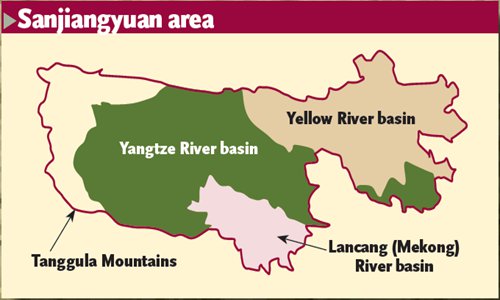
Improved ecology
Through the efforts of local residents and the local governments, the ecology of the Sanjiangyuan area has improved.
A recent report released by the Sanjiangyuan National Park said many types of vegetation in the park have been increasing in numbers and the ecological environment has improved since the government injected more than 10 billion yuan into environmental protection and restoration, the Xinhua reported on March 13.
Meanwhile, the number of rare animal species has been growing steadily in the Sanjiangyuan National Park as the area's environment continues to improve, according to an official report, Xinhua said.
However, the project still has a long way to go.
Du noted that the resettlement created several "ecological enclaves," which caused difficulties in terms of government management. Meanwhile, some of those who left did not have much grassland before, resulting in lower subsidies. Because of this, a small group of them have been trying to move back to the grassland.
Moreover, conflicts over land still exist in natural preservation work, the Global Times reporter learned. For instance, Tanggula town residents are currently in a dispute over grassland with the Hoh Xil preservation station.
Li Xiaonan, director of the administration bureau of Sanjiangyuan National Park, said in January 2018 that China's first national park in the Sanjiangyuan area will open in 2020, according to Xinhua.
Under the project, herders and farmers will become the central forces of environmental protection at Sanjiangyuan. The project is expected to provide jobs, boost incomes and give people an incentive to protect the environment.
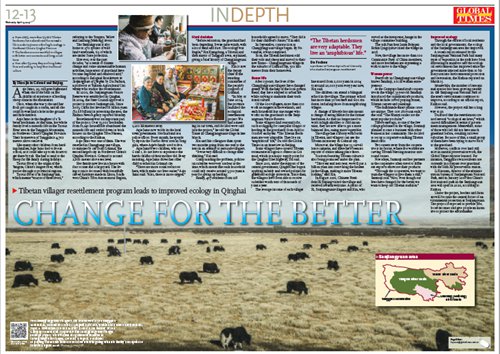
○ The herdsmen were resettled in villages with better environments and living conditions
○ Now after 15 years, they are living better lives and seeking to keep their traditional culture

The Changjiangyuan villagers' old hometown in the Tanggula Mountains, Northwest China's Qinghai Province, which has a harsh environment. Photo: Li Hao/GT
Aqie Jamo, 29, still gets frightened when she looks back on her childhood experience of herding sheep alone in the mountains.
Once, when she was 7, she and her flock got caught in a storm, and all she could do was find a hole in the ground and hide inside it.
Aqie Jamo is the daughter of a Tibetan herdsman. At that time, her whole family lived a nomadic life in the Tuotuo River area in the Tanggula Mountains, in Northwest China's Qinghai Province. Their hometown of Tanggula is 4,700 meters above sea level.
Like many other children from herding families, Aqie Jamo had to live at school, as it could take up to six hours to get there by yak. She had to tend to the sheep for the family during holidays.
Tuotuo River is the origin of the Yangtze, China's longest river, which passes through 11 provincial regions.
Tuotuo River is in Sanjiangyuan, which means "source of three rivers," referring to the Yangtze, Yellow and Lancang (Mekong) rivers.
The Sanjiangyuan is also home to 270 species of wild land vertebrates, 69 of which are under State protection.
However, over the past decades, "as a result of climate change and some unreasonable human activities, large areas of grassland have become degraded and rendered arid," according to Ecological Resettlement in Sanjiangyuan of Qinghai by Du Fachun, a professor at Yunnan Agricultural University who studies the resettlement.
In 2000, the Sanjiangyuan Nature Reserve was established in Qinghai. In 2004, the State Council approved a project to protect Sanjiangyuan. Since 2005, China has invested 18 billion yuan ($2.68 billion) in protecting the area, the Xinhua News Agency reported Monday.
Resettlement was an important part of the project. Over 55,000 herdsmen from 10,140 households abandoned the nomadic life and settled down in brick houses on the Qinghai-Tibet Plateau, according to the Xinhua.
Aqie Jamo was one of them. She was resettled in Changjiangyuan village, 10 minutes by car from Golmud, the second largest city in Northwest China's Qinghai Province. Golmud is around 2,800 meters above sea level.
Her family now live in a house with four rooms and a large yard. The living room is decorated with beautifully carved furniture made in Lhasa, Southwest China's Tibet Autonomous Region, 1,200 kilometers away.
Aqie Jamo now works in the local town government. Her husband is a police officer. Every month, he spends 15 days in the Tuotuo River area in Tanggula, where Aqie's family used to live.
Aqie Jamo's two children, who are 6 and 1, do not have to experience the harsh childhood their mother did. Every morning, Aqie Jamo drives her older child to school in Golmud city.
"There are more social resources here, which make our lives easier," Aqie Jamo said. "Also, there is more oxygen."

A craftsman carves a Marnyi Stone in the factory of the Gampapo handicraft cooperative in Changjiangyuan village. Photo: Li Hao/GT
Hard decision
"Before relocation, the grassland had been degrading. It was quite windy, with a lot of sand and dust. The ecology was fragile," Xin Xiangdong, a Tibetan and then mayor of Tanggula town, explained, giving a brief history of Changjiangyuan village.
Xin is now the deputy chief of the standing committee of the people's congress of Golmud.
"In May or June 2004, the province launched the ecological resettlement project. We had a meeting in our town, and decided we would join the project," he told the Global Times in Changjiangyuan village in late March.
Xin and his colleagues then spent two months going from one tent to the next in an attempt to persuade villagers.
"It was very difficult to change their thinking," Xin said.
Compounding the problem, policies on subsides were very unclear at the time, which meant that each household could only receive around 5,500 yuan a year for giving up herding.
Finally, 407 residents from 128 households agreed to move. "They did it for their children's future," Xin said.
In September, construction at Changjiangyuan village began. By November, it was completed.
Soon, the Tibetan herdsmen sold their yaks and sheep and moved to their new home - Changjiangyuan village in the suburbs of Golmud city, 500 kilometers from their hometown.

Shen'ge (right), his wife and his grandson at home in Changjiangyuan village, Golmud, Qinghai. President Xi Jinping visited his home to see how life was going with his family and spoke to them in August 2016. Photo: Li Hao/GT
Better life
After 15 years, the lives of the Changjiangyuan villagers have changed greatly. With the help of the local government, they have adapted to urban life while striving to maintain their traditional culture.
Of the 600 villagers, more than 100 work as rangers in the wetlands, and each household has one ranger who works on the grasslands at the Sanjiangyuan Nature Reserve.
Some villagers find seasonal jobs, such as digging for caterpillar fungus or herding in the grasslands from April to October each year. "The Tibetan herdsmen are very adaptable. They live an 'amphibious' life," Du told the Global Times in an interview in Beijing.
Some villagers have opened Tibetan restaurants in logistics centers in Golmud, which is a major supply point for the Qinghai-Tibet highway, Du said.
Since 2011, under the support of the central government, Qinghai has begun applying subsidy and reward policies for grassland ecology protection. Since then, the villagers have been able to receive subsidies worth tens of thousands of yuan a year.
The average income of each villager has soared from 2,000 yuan in 2004 to around 20,000 yuan every year now, Xin said.
The children can attend a bilingual school in the village. The primary school has more than 50 teachers and 600 students, including those from neighboring villages.
A change of lifestyle has also meant a change of eating habits for the former herdsmen. As they no longer need to work in high altitudes or cold mountains, they are now able to get a more balanced diet, eating more vegetables.
The village has a library with books in Tibetan, and villagers can use the Tibetan monastery in Golmud city.
Moreover, the village has 59 surveillance cameras, and there have been no reports of crimes taking place there.
Tourism featuring Tibetan culture is also being promoted under the plan.
"This year and next year, we will put 2 billion yuan into renovating the houses in the village, making it more Tibetan-looking," said Xin.
In August 2016, Chinese President Xi Jinping visited the village and received a warm welcome. A photo of Xi, Sanjiangyuan villagers and Xin, who served as the interpreter, hangs in the village committee building.
The 11th Panchen Lama Bainqen Erdini Qoigyijabu visited the village in 2018.
Now, the village has more than 100 Communist Party of China members, and more herdsmen are expressing a wish to move to the village.

Woman power
Everybody in Changjiangyuan village knows Sanmuji, a local woman entrepreneur.
At the Gampapo handicraft cooperative in the village, 33-year-old Sanmuji introduced the organization's products, which include carved praying stones, Tibetan carpets and paintings.
"The handmade smart phone cases are unique. They cost 280 yuan each," she said. "The Marnyi stones are the most popular products."
Three years ago, as one of the few college graduates in the village, Sanmuji planned to start a business with other women in her community. She decided to set up a cooperative making Tibetan handcrafts.
Two streets away from the cooperative is its factory, where five workers are carving Tibetan blessing mantras onto round stones.
Nowadays, Sanmuji and her partners at the cooperative often travel to different expos to showcase their products.
"Through the cooperative, we want to train the villagers to give them a skill," Sanmuji said. "Also, even though our lives have changed for the better, we want to keep our Tibetan tradition."

Improved ecology
Through the efforts of local residents and the local governments, the ecology of the Sanjiangyuan area has improved.
A recent report released by the Sanjiangyuan National Park said many types of vegetation in the park have been increasing in numbers and the ecological environment has improved since the government injected more than 10 billion yuan into environmental protection and restoration, the Xinhua reported on March 13.
Meanwhile, the number of rare animal species has been growing steadily in the Sanjiangyuan National Park as the area's environment continues to improve, according to an official report, Xinhua said.
However, the project still has a long way to go.
Du noted that the resettlement created several "ecological enclaves," which caused difficulties in terms of government management. Meanwhile, some of those who left did not have much grassland before, resulting in lower subsidies. Because of this, a small group of them have been trying to move back to the grassland.
Moreover, conflicts over land still exist in natural preservation work, the Global Times reporter learned. For instance, Tanggula town residents are currently in a dispute over grassland with the Hoh Xil preservation station.
Li Xiaonan, director of the administration bureau of Sanjiangyuan National Park, said in January 2018 that China's first national park in the Sanjiangyuan area will open in 2020, according to Xinhua.
Under the project, herders and farmers will become the central forces of environmental protection at Sanjiangyuan. The project is expected to provide jobs, boost incomes and give people an incentive to protect the environment.


